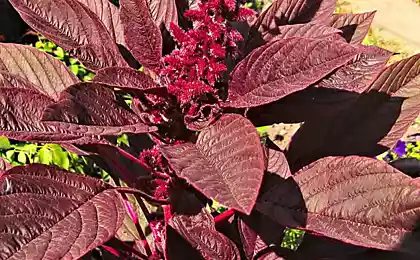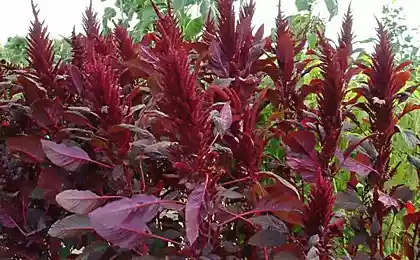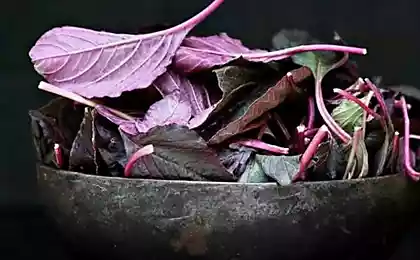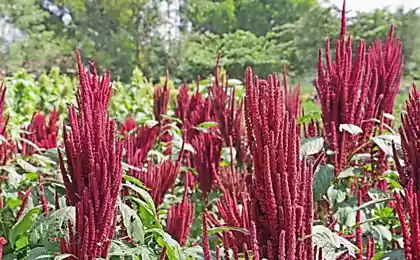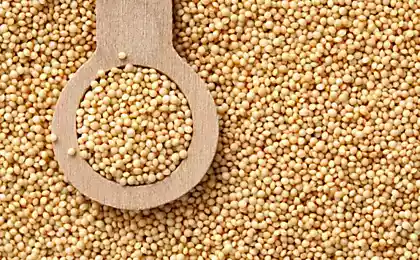1111
Amaranth
Extremely useful and very beautiful plant that is eaten. This pantry magnesium, protein, squalene and other nutrients. Discover the many new things about the amaranth!

Amaranthus (amaranth) is a common annual herb, small flowers which are collected in dense inflorescences. The common people were called "rooster combs", "amaranth", "cat's tail", "aksamitnik". Homeland amaranth - South America, where now there is a set of his species. The Russian hit in the second half of the century, and almost immediately began to be considered a noxious weed. Previously, he was denied by Peter I, while in Chinese medicine was considered an anti-aging agent. The Aztecs recognized him as their bread, the ancient Greeks - the symbol of immortality (inflorescence plants never fade). Japanese correlate the nutritional value of amaranth greens with meat squid, and it sprouted grains - with milk.
Videos about the amaranth plant - like growing:
literally word "amaranth" means "denying death." Today, the UN World Food amaranth Commission recognized the best culture of the XXI century.
How to use amaranth: recipes
Amaranth is ideally suited to those people who have contraindications to the use glyutensoderzhaschih products. Generally, the seeds of this plant has long been used for their beneficial properties. For example, in "dopshenichnoe" time in Russia amaranth seeds were good for making bread. Now Amaranth, which resembles the taste of nuts, has become popular throughout the world, including Russia.
Porridge
Amaranth porridge
Porridge from amaranth seeds are prepared mainly with fruit pieces, so tasty.
For its preparation must take a glass of seeds and 3 cups of water. Water bring to a boil and pour the seeds, they'll float up - this is normal. Make a smaller fire and cook until the moment when the grain will sink to the bottom. Next, be sure to cover the pan with a lid, as the seeds start to burst and severely shoot up! Periodically opening the lid to stir the porridge, it is advisable to take a wooden spoon with a long handle, so as not to burn your hands. Boil a total of 35-40 minutes. You can pour the boiled water if necessary.
Recipe amaranth porridge
Ready porridge of amaranth should be gentle. Further optional add fruit or dried fruit and nuts. Alternatively, you can have cinnamon or honey, as the taste of the porridge unique and not everyone likes. I do it personally and could not eat, disgusting taste. Barely I ate one serving, but it is very satisfying and high-calorie, high in protein and fat (including omega-3). Useful properties of amaranth are enormous, so we need to force through a little shove this gruel. In this porridge no gluten - a storehouse for those allergic to gluten
! Amaranth grain bread
Ingredients: 1 teaspoon of baking soda, 1 cup whole wheat flour, 1 egg white, 3/4 cup vysokolizinnoy wheat flour, 3/4 cup amaranth seed, 1 tablespoon margarine, melted 1 cup of fat-free cream
<. br> Preparation: Sift the soda with the flour and mix with other dry ingredients. Beat the egg and add it to the milk and melted margarine. Mix well and combine with dry products. Then put the resulting mass into a greased tin dish and bake in a hot oven for about 25 minutes.
Amaranth, oat bread
Ingredients: 2 cups Oat, amaranth flour mixture, 2 cups of boiling water, 2 teaspoons salt, 1/4 cup sugar and 1/2 cup molasses 1 package dry yeast 1/4 cup lukewarm water, 4 - 4 1/2 cup full of flour.
Preparation: Mix the flour and the dissolved sugar with 2 cups of hot water. All aside until cool. Dissolve the yeast in warm water. In a large saucepan, mix the yeast and flour mixture. Gradually add 4 cups flour. Knead until a homogeneous mass of dough on a floured board or in a kneader until the dough no longer sticks to the hands. Divide and form 2 rolls and put them on a greased baking sheet. Give them up twice, and then lower. Once again let rise twice. Bake at moderate temperature of 200 degrees 50-60 minutes.
The leaves are on salads, and amaranth flour turns out wonderful baked goods. Starch plant is characterized by high viscosity and swell, so it is often used for the production of confectionery, milk products and even beer.
If properly used in cooking the product (some add in salads, in pastries, soups, mixed with other cereals, etc.), it turns out very tasty. For example, pasta with amaranth liked in my family.
As a fodder crop, amaranth is of great importance for agriculture. Many of his views suited to pasture, grain, silage and green fertilizer. After the seeds are a useful feed for poultry and silage and greens well eat pigs and cattle. Furthermore, amaranth silage has a pleasant apple smell.
Amaranth leaves: how to cook
? First, they should problanshirovat for three minutes, or placed in boiling water for five minutes. Then ready-to-eat leaves can be added to appetizers, salads, side dishes. If desired, they can flavor with grated cheese, butter, boiled eggs and cheese.
The resulting decoction of amaranth is suitable for cooking borsch and soups, as well as a natural food coloring (beet is characterized by a bright color).
Amaranth Ingredients: caloric and vitamins
The grains contains proteins (16%), fat (7%), starch (62%), vitamins (thiamine, riboflavin, pantothenic, folic, ascorbic acid, pyridoxine, choline, niacin equivalent), pectins, macro- and minerals (magnesium, copper, iron, zinc, selenium, manganese, calcium, phosphorus, sodium, potassium).
Calorie
amaranth When compared to wheat, the wheat protein amaranth protein exceeds 2 times! More than 50% of proteins comprise albumin and globulin, which are characterized by a balanced amino acid composition. Underlying fat are linolenic, linoleic and oleic fatty acid.
Amaranth is the champion of the content magnesium Thus, 100 grams of rice this useful trace element only 50 g, wheat - 140 mg, while amaranth - 240 mg
! The stems and leaves, like spinach, contain sterols. They have a lot of vitamins C, E, B1, B2, flavonoids (quercetin, rutin, trefolina), proteins, carbohydrates and minerals.
Calorie amaranth (seeds) 100 g - 374 kcal (1565 kJ):
Protein - 14, 5 g
Fat - 6 5 g
Carbohydrates - 66, 7 g
Useful properties of amaranth
Useful properties of amaranth
The unique chemical composition of amaranth in many ways defined the area of its application. Thus, the ancient Aztec amaranth breastfed newborns, and the soldiers always took with them the seeds in many campaigns as a source of strength and health.
At the moment, amaranth is officially recognized as a means of helping in the treatment of inflammation of the urogenital system, anemia, atherosclerosis, hemorrhoids, loss of strength, vitamin deficiency, obesity, diabetes, skin diseases, neuroses, burns and periodontal disease, stomatitis, gastric ulcer and 12 duodenal ulcer. < br>
Amaranth oil as a source of squalene
Oil is full of unique substances, vitamins and trace elements, so its health benefits can not be overestimated. So, squalene is a substance exciting oxygen and tissues and organs saturating them. Thus squalene is among anticancer agents, preventing the occurrence of cancer. It is also a powerful immune stimulant, which until recently could only get out of the deep-sea shark liver, because of what was the most expensive and vysokodefitsitnym product. The problem was not only expensive, but also in the low content of squalene in Shark liver - only 1, 5%
. Squalene is needed deep-sea shark only to those able to survive under strong hypoxia at depth (lack of oxygen). People he is required as a fungicide, an anti-microbial and anti-cancer agents, it is known that hypoxia leads to the appearance of aging of the organism, and malignant tumors. In addition, the substance enhances the immune system and thus ensures its stability for all diseases.
The amaranth oil is from 8 to 10% squalene, which is several times greater than the amount in the liver of sharks! This is an incredible benefit to the body! It contributes to a better absorption of vitamin A and improve the regeneration of tissues of internal organs, which significantly speeds up the recovery of patients after radiation therapy.
How useful fiber amaranth
Fiber amaranth,
benefits In pharmacies and specialized departments of stores can be found in the sale of fiber amaranth seeds. It is produced in the form of a powder intended for dietary use. The composition has 50% fat, 20% protein, calcium, phosphorus, zinc, magnesium, iron, chlorine and others. Cellulose is a source of an ideal protein, minerals and water soluble vitamins (PP, C, E, B1, B6, B2, B12 ). It is also present quercetin, anthocyanidins, resveratrol.
The tool helps to cleanse the colon, normalizes the composition of intestinal microflora and helps to improve its function. The product is recommended for use when breastfeeding a child dystrophy, strong psycho-emotional and physical stress, chronic colitis, dysbacteriosis, diseases of the prostate, as well as living and working on environmentally hazardous areas. The course of treatment is 30 days. You must first fill it with water (it is possible and better yogurt or juice) and take 1-2 dessert spoon during meals (three times daily). I sometimes add fiber in oatmeal or bowl of soup, so pleasant and convenient to eat it, or pouring just plain water - to drink, because of the bad taste will be very hard
. Planting
amaranth

Amaranthus (amaranth) is a common annual herb, small flowers which are collected in dense inflorescences. The common people were called "rooster combs", "amaranth", "cat's tail", "aksamitnik". Homeland amaranth - South America, where now there is a set of his species. The Russian hit in the second half of the century, and almost immediately began to be considered a noxious weed. Previously, he was denied by Peter I, while in Chinese medicine was considered an anti-aging agent. The Aztecs recognized him as their bread, the ancient Greeks - the symbol of immortality (inflorescence plants never fade). Japanese correlate the nutritional value of amaranth greens with meat squid, and it sprouted grains - with milk.
Videos about the amaranth plant - like growing:
literally word "amaranth" means "denying death." Today, the UN World Food amaranth Commission recognized the best culture of the XXI century.
How to use amaranth: recipes
Amaranth is ideally suited to those people who have contraindications to the use glyutensoderzhaschih products. Generally, the seeds of this plant has long been used for their beneficial properties. For example, in "dopshenichnoe" time in Russia amaranth seeds were good for making bread. Now Amaranth, which resembles the taste of nuts, has become popular throughout the world, including Russia.
Porridge
Amaranth porridge
Porridge from amaranth seeds are prepared mainly with fruit pieces, so tasty.
For its preparation must take a glass of seeds and 3 cups of water. Water bring to a boil and pour the seeds, they'll float up - this is normal. Make a smaller fire and cook until the moment when the grain will sink to the bottom. Next, be sure to cover the pan with a lid, as the seeds start to burst and severely shoot up! Periodically opening the lid to stir the porridge, it is advisable to take a wooden spoon with a long handle, so as not to burn your hands. Boil a total of 35-40 minutes. You can pour the boiled water if necessary.
Recipe amaranth porridge
Ready porridge of amaranth should be gentle. Further optional add fruit or dried fruit and nuts. Alternatively, you can have cinnamon or honey, as the taste of the porridge unique and not everyone likes. I do it personally and could not eat, disgusting taste. Barely I ate one serving, but it is very satisfying and high-calorie, high in protein and fat (including omega-3). Useful properties of amaranth are enormous, so we need to force through a little shove this gruel. In this porridge no gluten - a storehouse for those allergic to gluten
! Amaranth grain bread
Ingredients: 1 teaspoon of baking soda, 1 cup whole wheat flour, 1 egg white, 3/4 cup vysokolizinnoy wheat flour, 3/4 cup amaranth seed, 1 tablespoon margarine, melted 1 cup of fat-free cream
<. br> Preparation: Sift the soda with the flour and mix with other dry ingredients. Beat the egg and add it to the milk and melted margarine. Mix well and combine with dry products. Then put the resulting mass into a greased tin dish and bake in a hot oven for about 25 minutes.
Amaranth, oat bread
Ingredients: 2 cups Oat, amaranth flour mixture, 2 cups of boiling water, 2 teaspoons salt, 1/4 cup sugar and 1/2 cup molasses 1 package dry yeast 1/4 cup lukewarm water, 4 - 4 1/2 cup full of flour.
Preparation: Mix the flour and the dissolved sugar with 2 cups of hot water. All aside until cool. Dissolve the yeast in warm water. In a large saucepan, mix the yeast and flour mixture. Gradually add 4 cups flour. Knead until a homogeneous mass of dough on a floured board or in a kneader until the dough no longer sticks to the hands. Divide and form 2 rolls and put them on a greased baking sheet. Give them up twice, and then lower. Once again let rise twice. Bake at moderate temperature of 200 degrees 50-60 minutes.
The leaves are on salads, and amaranth flour turns out wonderful baked goods. Starch plant is characterized by high viscosity and swell, so it is often used for the production of confectionery, milk products and even beer.
If properly used in cooking the product (some add in salads, in pastries, soups, mixed with other cereals, etc.), it turns out very tasty. For example, pasta with amaranth liked in my family.
As a fodder crop, amaranth is of great importance for agriculture. Many of his views suited to pasture, grain, silage and green fertilizer. After the seeds are a useful feed for poultry and silage and greens well eat pigs and cattle. Furthermore, amaranth silage has a pleasant apple smell.
Amaranth leaves: how to cook
? First, they should problanshirovat for three minutes, or placed in boiling water for five minutes. Then ready-to-eat leaves can be added to appetizers, salads, side dishes. If desired, they can flavor with grated cheese, butter, boiled eggs and cheese.
The resulting decoction of amaranth is suitable for cooking borsch and soups, as well as a natural food coloring (beet is characterized by a bright color).
Amaranth Ingredients: caloric and vitamins
The grains contains proteins (16%), fat (7%), starch (62%), vitamins (thiamine, riboflavin, pantothenic, folic, ascorbic acid, pyridoxine, choline, niacin equivalent), pectins, macro- and minerals (magnesium, copper, iron, zinc, selenium, manganese, calcium, phosphorus, sodium, potassium).
Calorie
amaranth When compared to wheat, the wheat protein amaranth protein exceeds 2 times! More than 50% of proteins comprise albumin and globulin, which are characterized by a balanced amino acid composition. Underlying fat are linolenic, linoleic and oleic fatty acid.
Amaranth is the champion of the content magnesium Thus, 100 grams of rice this useful trace element only 50 g, wheat - 140 mg, while amaranth - 240 mg
! The stems and leaves, like spinach, contain sterols. They have a lot of vitamins C, E, B1, B2, flavonoids (quercetin, rutin, trefolina), proteins, carbohydrates and minerals.
Calorie amaranth (seeds) 100 g - 374 kcal (1565 kJ):
Protein - 14, 5 g
Fat - 6 5 g
Carbohydrates - 66, 7 g
Useful properties of amaranth
Useful properties of amaranth
The unique chemical composition of amaranth in many ways defined the area of its application. Thus, the ancient Aztec amaranth breastfed newborns, and the soldiers always took with them the seeds in many campaigns as a source of strength and health.
At the moment, amaranth is officially recognized as a means of helping in the treatment of inflammation of the urogenital system, anemia, atherosclerosis, hemorrhoids, loss of strength, vitamin deficiency, obesity, diabetes, skin diseases, neuroses, burns and periodontal disease, stomatitis, gastric ulcer and 12 duodenal ulcer. < br>
Amaranth oil as a source of squalene
Oil is full of unique substances, vitamins and trace elements, so its health benefits can not be overestimated. So, squalene is a substance exciting oxygen and tissues and organs saturating them. Thus squalene is among anticancer agents, preventing the occurrence of cancer. It is also a powerful immune stimulant, which until recently could only get out of the deep-sea shark liver, because of what was the most expensive and vysokodefitsitnym product. The problem was not only expensive, but also in the low content of squalene in Shark liver - only 1, 5%
. Squalene is needed deep-sea shark only to those able to survive under strong hypoxia at depth (lack of oxygen). People he is required as a fungicide, an anti-microbial and anti-cancer agents, it is known that hypoxia leads to the appearance of aging of the organism, and malignant tumors. In addition, the substance enhances the immune system and thus ensures its stability for all diseases.
The amaranth oil is from 8 to 10% squalene, which is several times greater than the amount in the liver of sharks! This is an incredible benefit to the body! It contributes to a better absorption of vitamin A and improve the regeneration of tissues of internal organs, which significantly speeds up the recovery of patients after radiation therapy.
How useful fiber amaranth
Fiber amaranth,
benefits In pharmacies and specialized departments of stores can be found in the sale of fiber amaranth seeds. It is produced in the form of a powder intended for dietary use. The composition has 50% fat, 20% protein, calcium, phosphorus, zinc, magnesium, iron, chlorine and others. Cellulose is a source of an ideal protein, minerals and water soluble vitamins (PP, C, E, B1, B6, B2, B12 ). It is also present quercetin, anthocyanidins, resveratrol.
The tool helps to cleanse the colon, normalizes the composition of intestinal microflora and helps to improve its function. The product is recommended for use when breastfeeding a child dystrophy, strong psycho-emotional and physical stress, chronic colitis, dysbacteriosis, diseases of the prostate, as well as living and working on environmentally hazardous areas. The course of treatment is 30 days. You must first fill it with water (it is possible and better yogurt or juice) and take 1-2 dessert spoon during meals (three times daily). I sometimes add fiber in oatmeal or bowl of soup, so pleasant and convenient to eat it, or pouring just plain water - to drink, because of the bad taste will be very hard
. Planting
amaranth

